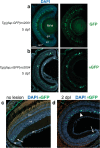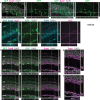Late-stage neuronal progenitors in the retina are radial Müller glia that function as retinal stem cells
- PMID: 17596452
- PMCID: PMC6672216
- DOI: 10.1523/JNEUROSCI.1624-07.2007
Late-stage neuronal progenitors in the retina are radial Müller glia that function as retinal stem cells
Abstract
Neuronal progenitors in the mammalian brain derive from radial glia or specialized astrocytes. In developing neural retina, radial glia-like Müller cells are generated late in neurogenesis and are not considered to be neuronal progenitors, but they do proliferate after injury and can express neuronal markers, suggesting a latent neurogenic capacity. To examine the neurogenic capacity of retinal glial cells, we used lineage tracing in transgenic zebrafish with a glial-specific promoter (gfap, for glial fibrillary acid protein) driving green fluorescent protein in differentiated Müller glia. We found that all Müller glia in the zebrafish retina express low levels of the multipotent progenitor marker Pax6 (paired box gene 6), and they proliferate at a low frequency in the intact, uninjured retina. Müller glia-derived progenitors express Crx (cone rod homeobox) and are late retinal progenitors that generate the rod photoreceptor lineage in the postembryonic retina. These Müller glia-derived progenitors also remain competent to produce earlier neuronal lineages, in that they respond to loss of cone photoreceptors by specifically regenerating the missing neurons. We conclude that zebrafish Müller glia function as multipotent retinal stem cells that generate retinal neurons by homeostatic and regenerative developmental mechanisms.
Figures










References
-
- Adolf B, Chapouton P, Lam CS, Topp S, Tannhauser B, Strahle U, Götz M, Bally-Cuif L. Conserved and acquired features of adult neurogenesis in the zebrafish telencephalon. Dev Biol. 2006;295:278–293. - PubMed
-
- Alvarez-Buylla A, Lim DA. For the long run: maintaining germinal niches in the adult brain. Neuron. 2004;41:683–686. - PubMed
-
- Anthony TE, Klein C, Fishell G, Heintz N. Radial glia serve as neuronal progenitors in all regions of the central nervous system. Neuron. 2004;41:881–890. - PubMed
-
- Barthel LK, Raymond PA. Improved method for obtaining 3-micron cryosections for immunocytochemistry. J Histochem Cytochem. 1990;38:1383–1388. - PubMed
-
- Bernardos RL, Raymond PA. GFAP transgenic zebrafish. Gene Expr Patterns. 2006;6:1007–1013. - PubMed
Publication types
MeSH terms
Grants and funding
LinkOut - more resources
Full Text Sources
Medical
Molecular Biology Databases
Research Materials
Miscellaneous
